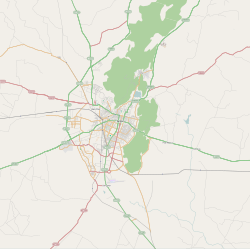Nindar
Nindar | |
|---|---|
Village | |
| Nickname: Neendar | |
| Coordinates: 27°01′15″N 75°45′53″E / 27.020787°N 75.764668°ECoordinates: 27°01′15″N 75°45′53″E / 27.020787°N 75.764668°E | |
| Country | |
| State | Rajasthan |
| District | Jaipur |
| Government | |
| • Body | Jaipur Municipal Corporation |
| Languages | |
| • Official | Hindi |
| Time zone | UTC+5:30 (IST) |
| PIN | 302013 |
| Telephone code | 0141 |
| ISO 3166 code | RJ-IN |
| Nearest city | Jaipur |
| Vidhan Sabha constituency | Vidyadhar Nagar |
| Civic agency | Jaipur Municipal Corporation |
Nindar (or Neendar,) is a village in Jaipur District, in the Indian state of Rajasthan.
Geography[edit]
It is situated about 10 km west of Amer in a direct line, but separated from Amber by hills and forests. It fell closer to Jaipur after Maharaja Sawai Jai Singh founded his new capital as Jaipur in 1727 CE. It is 2 km from NH 11 (Bikaner to Agra via Jaipur).[1][2] The village was included in Jaipur Municipal Corporation prior to 1995. The village is within sight of the Aravalli Range.
Culture[edit]
The village hosts a fort and a palace that are visible from National highway No. 08.
History[edit]
The village was granted under a jagir to Rao "Shivbramh" or "Sheobramh", the fourth son of Raja Udaikaran of Amber (1366–1388).[3] The descendants of Rao Sheobramh are known as Sheobramhpota.
Raja Prithviraj of Amber included the Sheobramhpota in the twelve principal houses of Amber called the Bara Kothri. A Tazimi thikana, it is notable that only three out of the twelve principal houses came from predecessors of Prithviraj.
Nindar was founded by Rao Shivbramh, the fourth son of Raja Udaikaranaji of Amber (Jaipur) 1366/1388. Shivbramh received villages, including Nindar, as his inheritance. Thereafter sons and grandsons of Shivbramha ruled Nindar until 1956 when the resumption of the Jagirs Act was passed.
Notables[edit]
- Rabat Gopaldas–commanded the Mughal Army under Raja Man Singh first after the defeat and death of Raja Birbal of Emperor Akbar. He also stopped Raja Todarmal at Khyber pass.
- Man Singh–ordered Gopaldas to clear the Khyber pass to reach Kabul. After clearing and crossing the pass, Man Singh defeated the five major Afgan tribes including Mandar and Yusufzai. The flag of Amber was converted into a five-colored flag.
- Gopaldas–was made Rawat from Rao.
- Rawat Harsh Vardhan Singh–current head and custodian of the gaddi since October 10, 2006.
The English film The Far Pavilions and Hindi film Gulal were shot inside and outside Nindar Palace and fort.
See also[edit]
- Sheobramhpota
- Kachwaha
References[edit]
- ↑ Neendar, (Rajasthan) Map, IndiaMapia
- ↑ Jaipur District Map, MapsOfIndia
- ↑ "Nindar" Princely States


